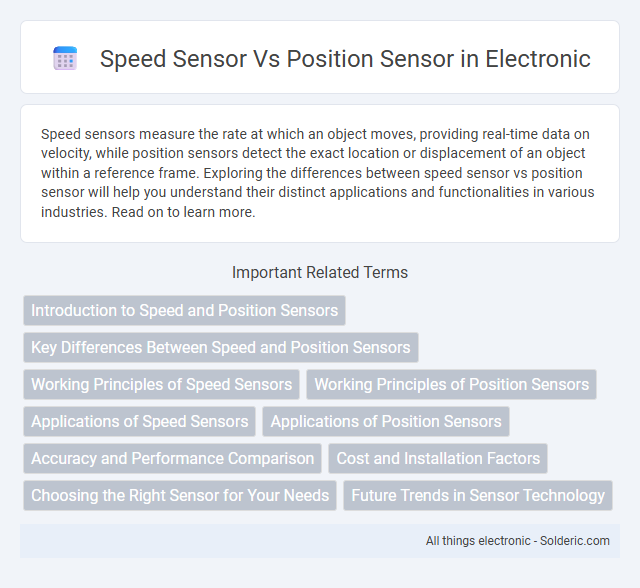Speed sensors measure the rate at which an object moves, providing real-time data on velocity, while position sensors detect the exact location or displacement of an object within a reference frame. Exploring the differences between speed sensor vs position sensor will help you understand their distinct applications and functionalities in various industries. Read on to learn more.
Comparison Table
| Feature | Speed Sensor | Position Sensor |
|---|---|---|
| Purpose | Measures the rate of movement or velocity of an object | Detects the exact location or angle of an object |
| Output | Speed or frequency signals (e.g., RPM, m/s) | Position data (e.g., degrees, linear displacement) |
| Common Types | Tachometers, Hall effect sensors, Optical encoders (speed mode) | Potentiometers, Optical encoders (absolute/ incremental), Linear variable differential transformers (LVDTs) |
| Applications | Motor control, automotive speed measurement, conveyor belts | Robotics, CNC machines, valve position monitoring |
| Output Nature | Dynamic, changes with motion speed | Static or dynamic, reflects exact position |
| Accuracy | High for velocity measurement | High for spatial accuracy |
| Dependency | Depends on change in position over time | Depends on absolute or relative positional reference |
Introduction to Speed and Position Sensors
Speed sensors measure the rate of change of an object's position over time, providing real-time velocity data essential for applications like motor control and automotive systems. Position sensors detect the exact location or angular displacement of an object, enabling precise control in robotics, manufacturing, and navigation. Understanding the distinct roles of speed and position sensors allows you to optimize system performance based on accurate motion and spatial measurements.
Key Differences Between Speed and Position Sensors
Speed sensors measure the rate of change of position over time, providing data on velocity or rotational speed, while position sensors detect the exact location or angular displacement of an object. Speed sensors often use technologies like Hall effect or magnetic pickups, whereas position sensors rely on encoders, potentiometers, or absolute sensors for precise positional feedback. The critical difference lies in speed sensors tracking motion dynamics, whereas position sensors focus on static or dynamic spatial orientation.
Working Principles of Speed Sensors
Speed sensors operate by detecting the rate of movement or rotation of an object, often using electromagnetic, optical, or magnetic technologies to convert mechanical motion into electrical signals. Common types include Hall effect sensors, which measure changes in magnetic fields caused by rotating gears, and optical encoders, which use light interruptions to determine rotational speed. These sensors provide real-time data essential for applications in automotive systems, industrial machinery, and robotics for precise control and monitoring of velocity.
Working Principles of Position Sensors
Position sensors operate by detecting the physical location or displacement of an object relative to a reference point, using methods such as potentiometric, inductive, capacitive, or optical sensing. These sensors translate mechanical movement into an electrical signal that accurately reflects angular or linear position, enabling precise control in applications like robotics and industrial automation. Your choice between speed and position sensors depends on whether you need real-time velocity measurement or accurate positional feedback.
Applications of Speed Sensors
Speed sensors are widely used in automotive systems for monitoring engine RPM, enhancing vehicle stability control, and optimizing transmission shifting. Industrial machinery relies on speed sensors to regulate conveyor belt speeds and ensure precise motor control in manufacturing processes. Additionally, speed sensors are critical in robotics and aerospace for real-time feedback to maintain accurate motion and enhance safety protocols.
Applications of Position Sensors
Position sensors are crucial in robotics, automotive systems, and industrial automation for precise measurement of angular or linear displacement. They enable accurate control of machinery and ensure safety in applications such as elevator systems, CNC machines, and robotic arms. Your ability to monitor and adjust the exact position of components improves performance and reduces wear in these technologies.
Accuracy and Performance Comparison
Speed sensors offer high accuracy in measuring the velocity of moving objects, providing real-time data essential for dynamic control systems, while position sensors excel in precise detection of the exact location or angular displacement, critical for applications requiring fine positional feedback. Performance-wise, speed sensors typically respond faster to changes in velocity, making them ideal for systems demanding quick adjustments, whereas position sensors deliver superior stability and resolution in static or slow-moving scenarios. Your choice depends on whether rapid velocity updates or detailed positional information is paramount for your specific application.
Cost and Installation Factors
Speed sensors generally have lower costs and simpler installation processes compared to position sensors due to their less complex design and fewer calibration requirements. Position sensors often demand precise alignment and more intricate setup, increasing both labor time and overall expense. The choice between the two depends on budget constraints and the specific application's tolerance for installation complexity.
Choosing the Right Sensor for Your Needs
Choosing the right sensor depends on your specific application requirements: speed sensors excel in monitoring rotational or linear velocity for real-time feedback, while position sensors provide precise measurements of an object's exact location or displacement. For dynamic control systems, speed sensors such as tachometers or Hall-effect sensors ensure accurate velocity detection, whereas position sensors like potentiometers, encoders, or laser displacement sensors offer high-resolution position tracking. Evaluating factors such as measurement range, accuracy, response time, and environmental conditions will guide the optimal choice between speed and position sensors.
Future Trends in Sensor Technology
Future trends in sensor technology emphasize the integration of speed sensors and position sensors into multi-functional smart sensor systems with enhanced precision and real-time data processing capabilities. Advancements in MEMS (Micro-Electro-Mechanical Systems) and AI algorithms enable these sensors to deliver higher accuracy, lower power consumption, and improved durability for applications in autonomous vehicles, robotics, and industrial automation. Emerging trends also include wireless connectivity and edge computing, allowing seamless data transmission and instant decision-making in complex sensor networks.
speed sensor vs position sensor Infographic

 solderic.com
solderic.com